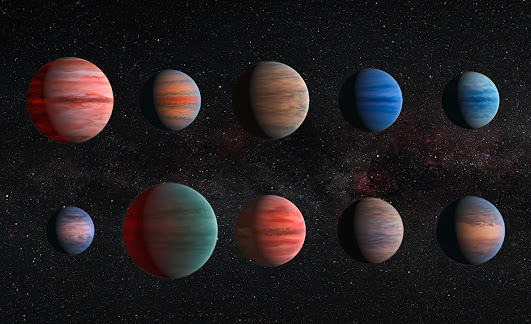In the boundless expanse of the cosmos,
beyond the familiar realms of our solar system, lie worlds of extraordinary
diversity and intrigue. These distant orbs, known as exoplanets, have captured
the imagination of astronomers and enthusiasts alike, offering tantalizing
glimpses into the vast tapestry of the universe. Among the pioneers in the
quest to unravel the mysteries of these celestial marvels is NASA, whose
relentless pursuit of exploration has led to the discovery of over 5,200
exoplanets to date. Here, we embark on a journey to explore 10 of the most
captivating exoplanets exposed by NASA's groundbreaking discoveries.
TIC 172900988 b: Nestled within a
mesmerizing binary star system, TIC 172900988 b stands as a testament to the
awe-inspiring complexity of the cosmos. Discovered in 2021, this Jupiter-sized
planet orbits its twin suns, creating a celestial ballet as it transits across
their faces, captivating observers on distant worlds and inspiring wonder among
astronomers on Earth.
AU Microscopii b: In the cosmic cradle
of one of the youngest planetary systems ever observed, AU Microscopii b
emerges as a beacon of exploration. Located less than 32 light-years away, this
enigmatic world orbits a star that exhibits extreme and violent activity,
offering a glimpse into the tumultuous genesis of planetary bodies.
Kepler-452 b: Dubbed Earth's older
cousin, Kepler-452 b invites speculation about the potential for
extraterrestrial life. Discovered in 2015, this exoplanet shares remarkable
similarities with our blue planet, orbiting a sun-like star within the
habitable zone where conditions may be conducive to life as we know it.
GJ 15 A b and GJ 15 A c: Among the
closest multi-planet neighbors to our solar system identified by NASA, GJ 15 A
b and GJ 15 A c orbit a red dwarf star a mere 11 light-years away. Discovered
in 2014, these worlds offer tantalizing opportunities for further exploration
and investigation into the diversity of planetary systems.
GJ 504: With its majestic magenta hue,
GJ 504 stands as a testament to the breathtaking beauty of the cosmos. This
colossal celestial body, discovered by NASA, radiates the warmth of its
creation, inviting contemplation of the forces that shape the universe.
Kepler-22b: Positioned within the
habitable zone of its star, Kepler-22b tantalizes scientists with the
possibility of liquid water on its surface. Discovered in 2011, this exoplanet
represents a prime target in the search for potentially habitable worlds beyond
our solar system.
Kepler-70b (KOI-55): Enduring
temperatures hotter than the surface of the sun, Kepler-70b faces a fiery fate
as it slowly evaporates under the intense heat of its dead star. Discovered in
2011, this hellish world offers insights into the tumultuous evolution of
planetary systems.
TrES-2 b: Shrouded in perpetual
darkness, TrES-2 b emerges as one of the darkest exoplanets known to science.
Discovered in 2006, this enigmatic world captivates astronomers with its eerie
glow and mysterious atmosphere, inviting speculation about its origins and
composition.


Post a Comment